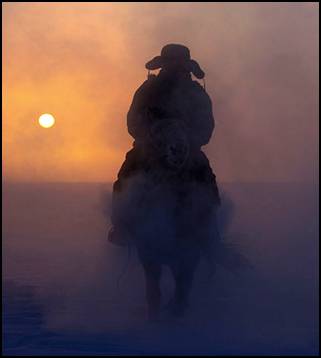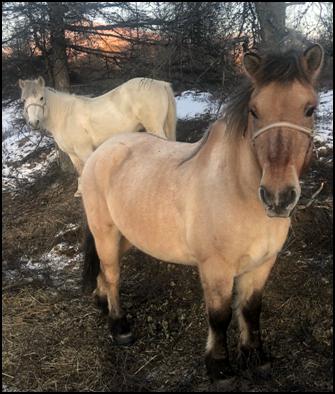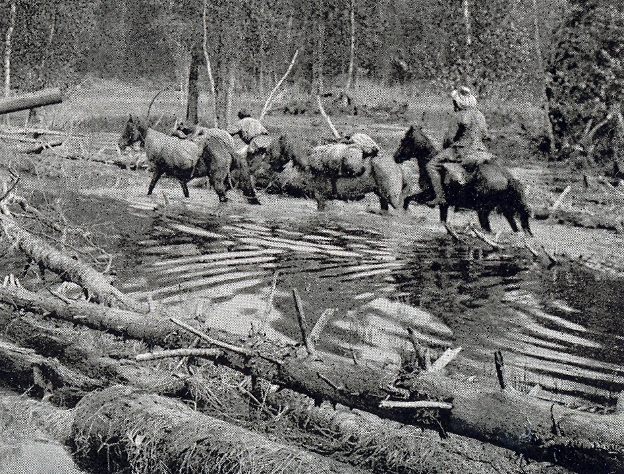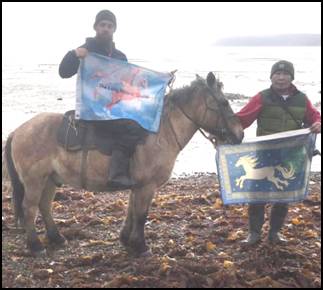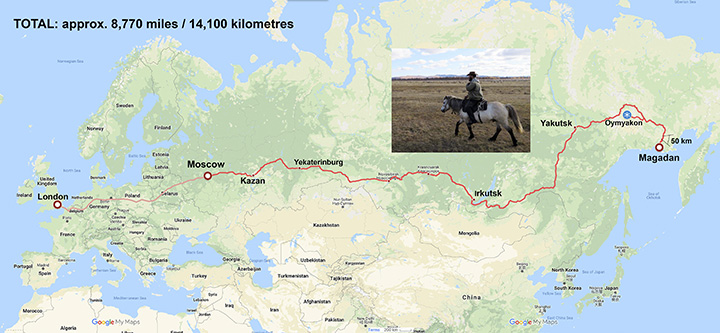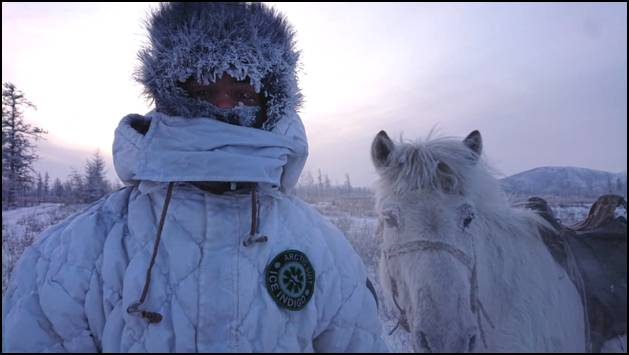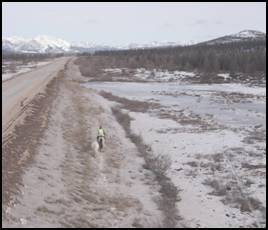|
The Last Great Journey – Solo across Siberia
by CuChullaine O’Reilly FRGS |
|
Photos courtesy of Nikita Gretsi and Egor Makarov. |
Early in the year 2020, the Long Riders’ Guild published an extensive report detailing how Nikita Gretsi was preparing to become the first person to attempt a solo equestrian journey from Russia’s Pacific to England’s Atlantic.
Available in Russian and English, the LRG article documented how Americans have been riding “ocean to ocean” since Willard Glazier traversed the country in 1875.
Yet the vast Eurasian continent has never been crossed by a Long Rider.
The first such attempt is now underway.
Preparing for the Pole of Cold
No equestrian traveller in modern history has undergone the extensive training and education which Nikita Gretsi has completed.
Having read the Encyclopaedia of Equestrian Travel and the Horse Travel Handbook, Nikita was then mentored by Long Riders with Russian, Siberian and Central Asian experience.
After completing a lengthy training ride across Mongolia, Nikita travelled north to the Republic of Sakha, homeland of the world’s oldest equestrian culture.
Consisting of 3,083,523 square kilometers (1,190,555 square miles), the republic is the largest sub-national governing body in the world. With a population of less than a million people, the inhabitants speak their own language, have a different culture and practice a different belief system than Russia Orthodoxy. More importantly, living within the borders of this frozen realm are the original Polar Riders whose astonishing horses thrive in the sub-zero temperatures around the notorious Pole of Cold.
There Nikita was befriended by Professor Ivanov Revory Vasilevich, who has documented the history of the ancient Yakut horses, an astonishing breed that thrives in minus 70 degree winters.
A fluent Russian speaker, Nikita has genetic, linguistic and cultural roots that reach across the vastness of Russia and his family’s history symbolizes what once was and what no longer exists.
“People often ask what my nationality is, and it’s difficult for me to immediately give one answer. Mom has Russian and Ukrainian background. Dad has Russian, Uzbek and Estonian. My great grandmother was born in Altai, Siberia. I was born in Estonia and grew up between that country and Ukraine, until I moved to England at the age of 7.”
This linguistic and cultural heritage enabled Nikita to winter in Siberia, where Sakha tribal elders taught him how to ride, travel and survive in sub-zero weather.
Trained, equipped and ready, Nikita’s dream to ride “ocean to ocean” across Eurasia was interrupted when the covid pandemic closed Russia to English travellers.
Covid and Climate Challenges
Having completed extensive training journeys in minus 60 degree weather, Nikita returned to England in late 2020. He planned to return to Siberia in a few months but travel restrictions left him stranded.
In April he gladly boarded a plane bound for Moscow. Unfortunately the plane landed in Warsaw, Poland. There Nikita and six other English passengers had to board an on-going flight to the Russian capital. Upon arrival the unsuspecting travellers were informed that a new law, passed two days before and not yet publicized, made it illegal to enter Russia via a Polish transit flight.
Nikita was forced to return to London immediately or face being isolated for months in a Russian quarantine facility.
In the subsequent months, the world’s largest wild fire devastated Siberia. Described as an apocalypse, some desperate communities even drafted children into the fight to hold back the flames. The extensive smoke, which could be seen from space, closed the state airport and restricted travel in and out of Siberia.
After being postponed for months, in early September the traveller was finally allowed to return to Russia. With the smoke clearing, Nikita flew on to Yakutsk, the Siberian capital. He then travelled hundreds of kilometres north into the taiga, where he was greeted by a renowned Yakut horse herder who had been waiting for the Long Rider’s arrival.
In the Hoof Prints of Legends
Among the herd of two hundred horses running wild deep in the taiga, Nikita chose two splendid Yakut horses. Artyk (17) is a strong and powerful road horse, while White (14) works well as the reliable pack horse.
|
White and Artyk are reminiscent of Mancha and Gato, the physically tough and mentally resilient Criollo horses that Aimé Tschiffely rode from Buenos Aires to New York in 1925. |
|
Like Tschiffely’s legendary Criollos, the Siberian horses were wild for most of their lives and travelling doesn't run counter to thousands of years of natural selection.
“Yakut horses are unique because they are built like incredibly strong little tanks. They are the only horses that not only survive but flourish in such harsh conditions,” Nikita said.
Prior to beginning the journey, Nikita made a training ride in the mountains of Sasyr, a remote northern locality inhabited by 700 people.
“We covered a distance of 450 kilometres in 12 days so the horses are definitely fit for travel.”
Across the Trackless Taiga
Even though Nikita had managed to survive covid, elude red tape, avoid wildfires, penetrate into the taiga, and find his horses, he was a long way from the Pacific Ocean.
To reach the coastal city of Magadan, Nikita had to hire a truck and driver to transport him and the horses 1,500 kilometres across Siberia. Because the taiga is an enormous wilderness, it took five days to cover the first 500 kilometres. The team had to travel across bogs, through forests, and alongside rivers, to find their way south to a paved road.
|
The term “taiga” refers to one of the world’s major ecosystems. The Russians have a word for this type of trap. They call it “rasputitsa,” meaning “roadlessness”. |
|
“Each day was filled with uncertainty. I wasn’t even sure we would make it to Magadan because no one drives off road during this time of year,” Nikita informed the Guild via email.
The Pacific at Last
Most would-be Long Riders would have completed their journey and returned home, but after enduring two years of training, a global pandemic, and the world’s largest wildfire, Nikita reached the Pacific Ocean at last.
On the morning of October 2nd, Nikita wrote, “I had dreamt of beginning my expedition at the Sea of Okhotsk, which is the northwestern arm of the Pacific Ocean. It was an intense moment when Artyk stepped into the water and I held the Guild flag above the waves.”
|
Nikita was greeted on the shores of the Pacific by “Friend of the Guild,” Egor Petrovich Makarov, a Siberian author, photographer and documentary film maker who has shared his extensive knowledge of Yakut horses with many Long Riders. They are seen holding the Long Riders’ Guild and World Ride flags. |
|
“After two years in the making, I am finally on the road and headed for London. As Tschiffely said, it’s time to taste the salt of life.”
From Magadan to Moscow
The journey, which began at the seaport of Magadan, will take Nikita along the infamous Road of Bones. Created by Joseph Stalin in 1932, an estimated million people died constructing it and now lie buried beneath or around the road.
Nikita’s first destination will be Oymyakon in Yakutia, the coldest permanently inhabited settlement on Earth.
Yet the landscape is proving to be even more barren than Nikita anticipated.
“Most of the villages that are on the maps have been abandoned. This is the most remote and isolated part of the world I’ve been to.”
Nevertheless it is not the cold that presents the greatest peril. Like modern Long Riders everywhere, Nikita and his horses are engaged in a deadly ballet with murderous drivers.
In 2013 the worst accident in the history of modern equestrian travel took the life of English Long Rider Christine Henchie. She was killed instantly by an out-of-control bus in Tanzania. Her fiancé, South African Long Rider Billy Brenchley, escaped death by inches but suffered a broken leg. Two Tanzanians walking alongside the travellers were slain. Twenty-five villagers, including two children, were seriously injured.
A shocked journalist said, “I thought the greatest dangers for a Long Rider were bandits or bears.”
He was wrong.
As Nikita quickly learned, the greatest danger is careless drivers.
“Yesterday we had a really close call when a lorry sped towards me at 80 kmph. He passed us with less than half a meter (20 inches) between his lorry and the horses. Needless to say the horses freaked out and jumped off the side of the road. We plummeted down but I managed to stay in the saddle and the horses are fine. We experience a lot of this every day but that was the worst so far. I honestly don’t know how we walked away from it.”
Complicating the problem is that Nikita has learned that is it unsafe to ride alongside the road because broken glass bottles and strands of old barbed wire are hidden under the snow. One length of barbed wire wrapped itself around Artyk’s front legs.
|
|
Riding in Minus 60
Protecting his horses and staying alive in the saddle are complicated by the fact that the team are travelling in blood freezing weather. The deadly Siberian cold is so extreme that even the liquid in a human eyeball will freeze. Nikita reported that the temperature has already dropped to minus 20.
To survive and ride in such extreme weather, Nikita has been equipped with an astonishing suit that will keep a human being warm in temperatures of minus 110 degrees.
Invented in Russia by the Extreme Scientific Research Centre, the Ice Indigo thermal suit is lightweight, durable and flexible. It has been successfully used on expeditions to the South and North Poles.
|
|
Nikita is the first Long Rider to use the Ice Indigo thermal suit. He is seen on a training ride which lasted for six hours and exposed him to minus 60 degree weather, during which time he stayed comfortably warm. |
Alone Across Siberia
Having struggled just to begin the journey, Nikita is in the saddle at last and making careful progress across the challenging landscape.
“The main problem will be reaching places where the horses can rest. In between there are wolves and bears wandering around the roads. I definitely feel every hour of the journey and every stone the horses step on.
Yet Nikita isn’t daunted.
"This isn't about a guy riding from A to B," Nikita said. "That's what a lot of people think.
The most important thing is discovering what is hidden inside you. In order to unlock that secret you have to delve deep into yourself and the culture. It's the people that are behind me like the Long Riders’ Guild, the Republic of Sakha, the tribal elders, and my friend Egor Makarov, who have taught me to travel in harmony with myself and Nature.”
|
“Tomorrow I ride on. It’s 200 kilometres until the next village.” |
|
Additional Information about the Journey
For more information about The Last Great Journey, or to contact Nikita via email, please visit his website.
|
In February 2021 a new adventure travel magazine entitled Russia Pro was launched. The premise is to document the journeys of “those who dare to make their dreams come true.” What followed was the largest equestrian travel edition ever published, eighteen illustrated pages that include interviews with Nikita and other equestrian explorers and a history of the Long Riders’ Guild. Simultaneously released in English and Russian, a PDF of the English edition is provided. Because of its large size, please allow time for it to load. |
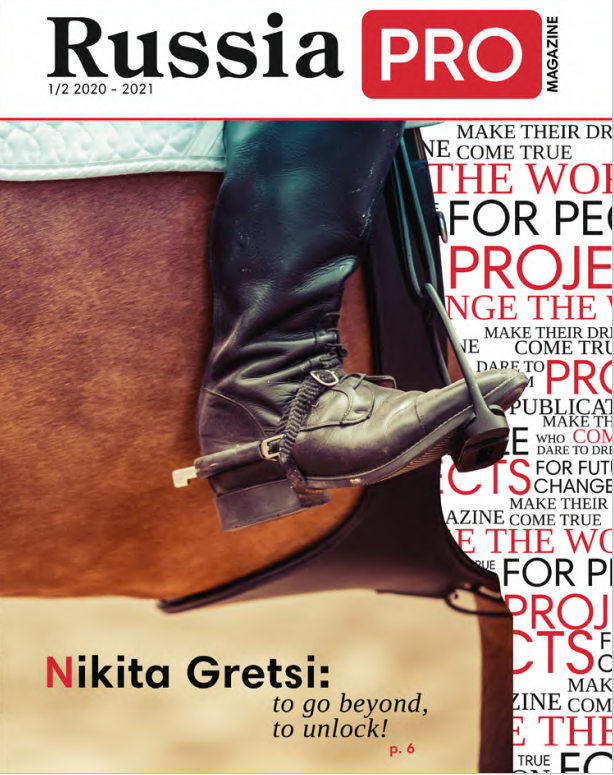
|
Additional Information about Siberia and Yakut Horses
Finding Siberia’s Legendary Yakut horses in 2004
Exploring Siberia’s Yakut Horse Culture in 2016
A Study of the Sakha (Yakut) Breed of Horse
Yakut Horses Could be Descended from Ice Age Horses
The Yakut Horse - Blood brother of the Sakha people
Polar Ponies – Siberian Horses in Antarctic Exploration
Main Stories from the Road page

